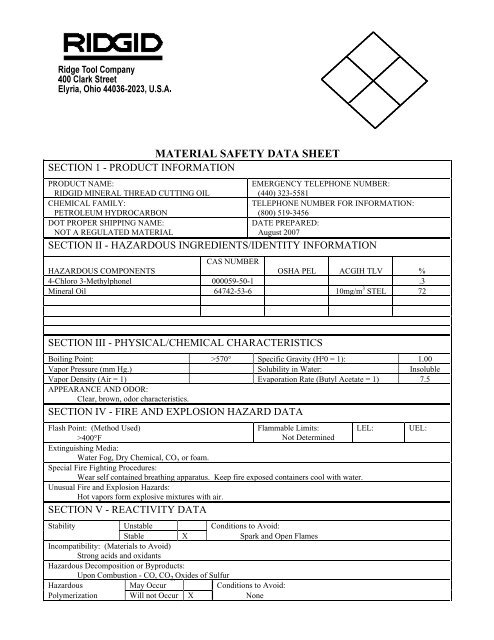Mineral Thread Cutting Oil - Ridgid
Mineral Thread Cutting Oil - Ridgid
Mineral Thread Cutting Oil - Ridgid
Create successful ePaper yourself
Turn your PDF publications into a flip-book with our unique Google optimized e-Paper software.
MATERIAL SAFETY DATA SHEET<br />
SECTION 1 - PRODUCT INFORMATION<br />
PRODUCT NAME:<br />
RIDGID MINERAL THREAD CUTTING OIL<br />
CHEMICAL FAMILY:<br />
PETROLEUM HYDROCARBON<br />
DOT PROPER SHIPPING NAME:<br />
NOT A REGULATED MATERIAL<br />
EMERGENCY TELEPHONE NUMBER:<br />
(440) 323-5581<br />
TELEPHONE NUMBER FOR INFORMATION:<br />
(800) 519-3456<br />
DATE PREPARED:<br />
August 2007<br />
SECTION II - HAZARDOUS INGREDIENTS/IDENTITY INFORMATION<br />
CAS NUMBER<br />
HAZARDOUS COMPONENTS<br />
OSHA PEL ACGIH TLV %<br />
4-Chloro 3-Methylphonel 000059-50-1 .3<br />
<strong>Mineral</strong> <strong>Oil</strong> 64742-53-6 10mg/m 3 STEL 72<br />
SECTION III - PHYSICAL/CHEMICAL CHARACTERISTICS<br />
Boiling Point: >570° Specific Gravity (H²0 = 1): 1.00<br />
Vapor Pressure (mm Hg.) Solubility in Water: Insoluble<br />
Vapor Density (Air = 1) Evaporation Rate (Butyl Acetate = 1) 7.5<br />
APPEARANCE AND ODOR:<br />
Clear, brown, odor characteristics.<br />
SECTION IV - FIRE AND EXPLOSION HAZARD DATA<br />
Flash Point: (Method Used)<br />
>400 F<br />
Flammable Limits:<br />
Not Determined<br />
Extinguishing Media:<br />
Water Fog, Dry Chemical, CO 2<br />
or foam.<br />
Special Fire Fighting Procedures:<br />
Wear self contained breathing apparatus. Keep fire exposed containers cool with water.<br />
Unusual Fire and Explosion Hazards:<br />
Hot vapors form explosive mixtures with air.<br />
SECTION V - REACTIVITY DATA<br />
Stability Unstable Conditions to Avoid:<br />
Stable X Spark and Open Flames<br />
Incompatibility: (Materials to Avoid)<br />
Strong acids and oxidants<br />
Hazardous Decomposition or Byproducts:<br />
Upon Combustion - CO, CO 2, Oxides of Sulfur<br />
Hazardous May Occur Conditions to Avoid:<br />
Polymerization Will not Occur X None<br />
LEL:<br />
UEL:
SECTION VI - HEALTH HAZARD DATA<br />
Route(s) of Entry: Inhalation Skin Ingestion<br />
X X X<br />
Health Hazards: (Acute and Chronic)<br />
Causes Irritation - May be skin defatter upon prolonged or repeated contact.<br />
Carcinogenicity: IARC Monographs: Vol. 33<br />
Sufficient evidence that mildly hydro treated oils are carcinogenic to experimental animals.<br />
Signs and Symptoms of Exposure:<br />
<strong>Oil</strong> mist inhalation may cause dizziness, nausea and difficult breathing.<br />
Medical Conditions Generally Aggravated by Exposure:<br />
Sensitive Dry Skin.<br />
Emergency and First Aid Procedures:<br />
Swallowing: Do not induce vomiting. Get Medical attention.<br />
Skin: Wash with soap and water.<br />
Eyes: Flush eyes with plenty of water for 15 minutes. Call a physician.<br />
Inhalation: Remove to fresh air and give artificial respiration if necessary.<br />
SECTION VII - PRECAUTIONS FOR SAFE HANDLING AND USE.<br />
Steps to be Taken in Case Material is Released or Spilled:<br />
Do not use water - Soak up with sand, earth or other inert material. Put in suitable container.<br />
Waste Disposal Method:<br />
Dispose of material in accordance with government regulations. Avoid contamination of sewers and water ways.<br />
Precautions to be Taken in Handling and Storing:<br />
Avoid contact with eyes, skin, and clothing. Remove contaminated clothing. Launder before re-use. Wash<br />
thoroughly after handling. Store between 40 and 115 F.<br />
Other Precautions:<br />
Avoid breathing mist or vapors.<br />
SECTION VIII CONTROL MEASURES<br />
Respiratory Protection (Specify Type):<br />
Use NISOH approved respirator if engineering or other controls are not adequate to reduce airborne exposure to<br />
below permissible limits.<br />
Ventilation:<br />
Local exhaust recommended.<br />
Protective Gloves:<br />
Neoprene <strong>Oil</strong> Impervious<br />
Eye Protection:<br />
Safety Glasses or Goggles<br />
Other Protective Clothing or Equipment:<br />
Aprons, <strong>Oil</strong> Repellent Barrier Creme or other as required to avoid skin contact.<br />
Work/Hygienic Practices:<br />
Wash after handling.<br />
SECTION IX<br />
TSCA:<br />
REGULATORY INFORMATION<br />
Sara Title III:<br />
WE BELIEVE THE STATEMENTS, TECHNICAL INFORMATION AND RECOMMENDATIONS CONTAINED HEREIN ARE RELIABLE, BUT<br />
THEY ARE GIVEN WITHOUT WARRANTY OR GUARANTEE OF ANY KIND, EXPRESSED OR IMPLIED, AND WE ASSUME NO<br />
RESPONSIBILITY FOR ANY LOSS, DAMAGE, OR EXPENSE, DIRECT OR CONSEQUENTIAL, ARISING OUT OF THEIR USE.
















